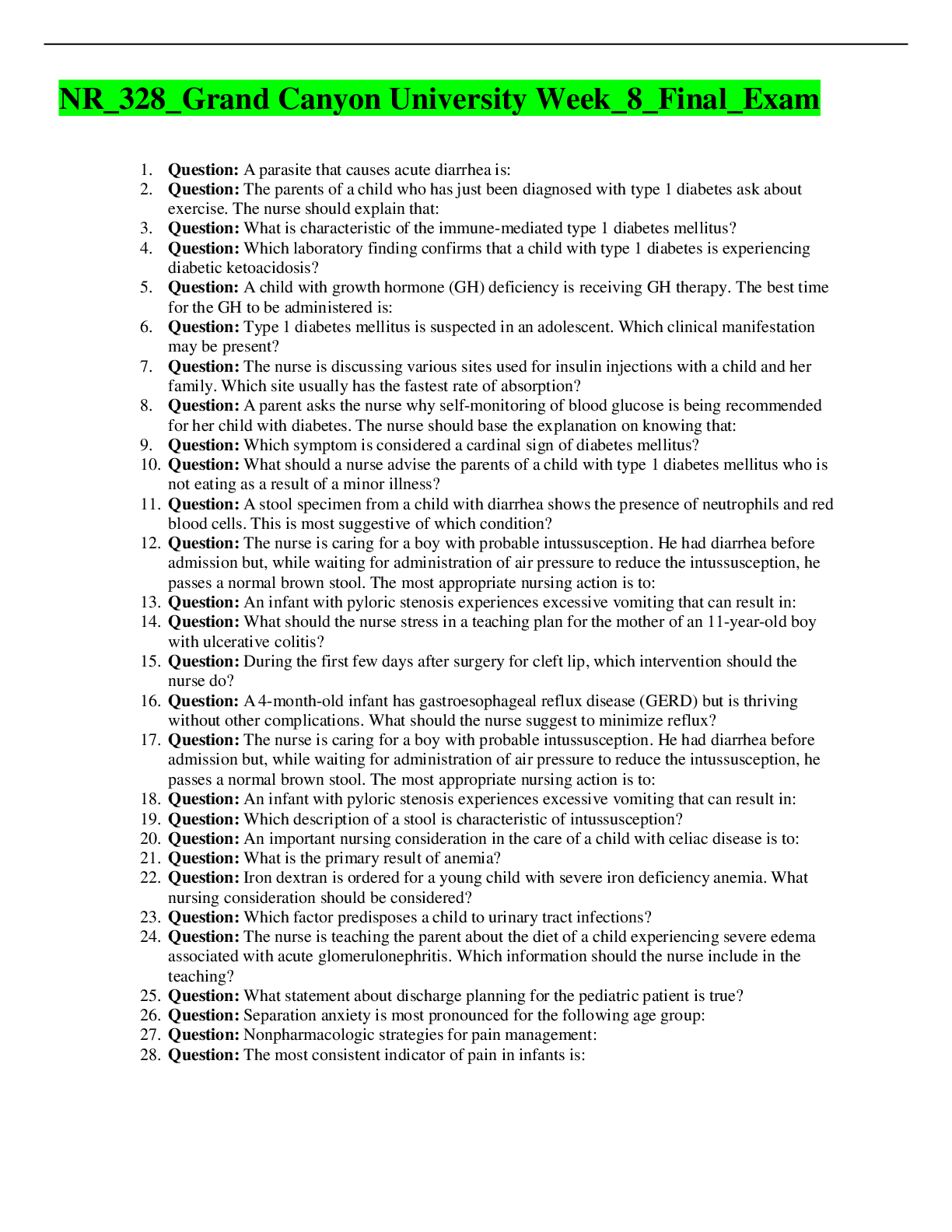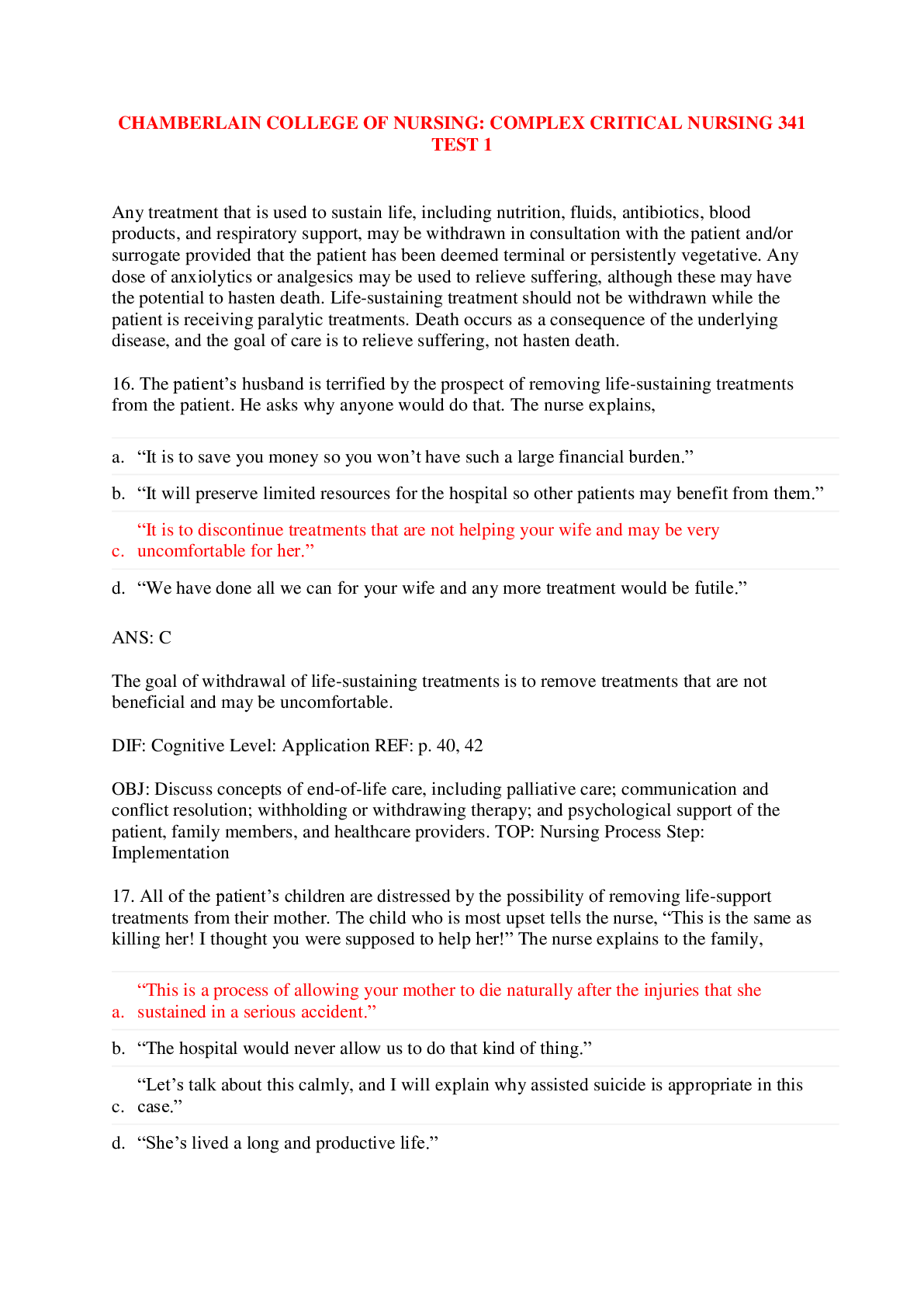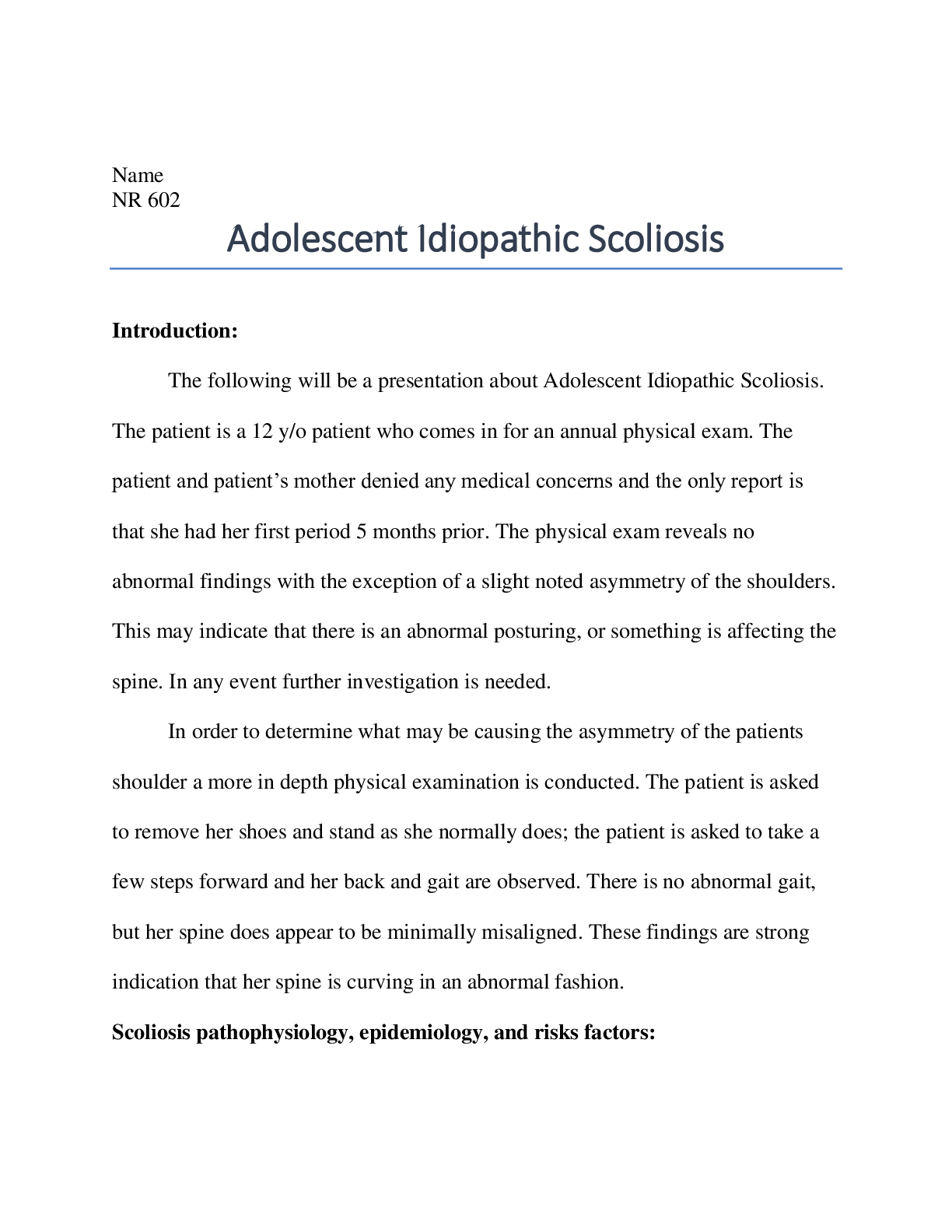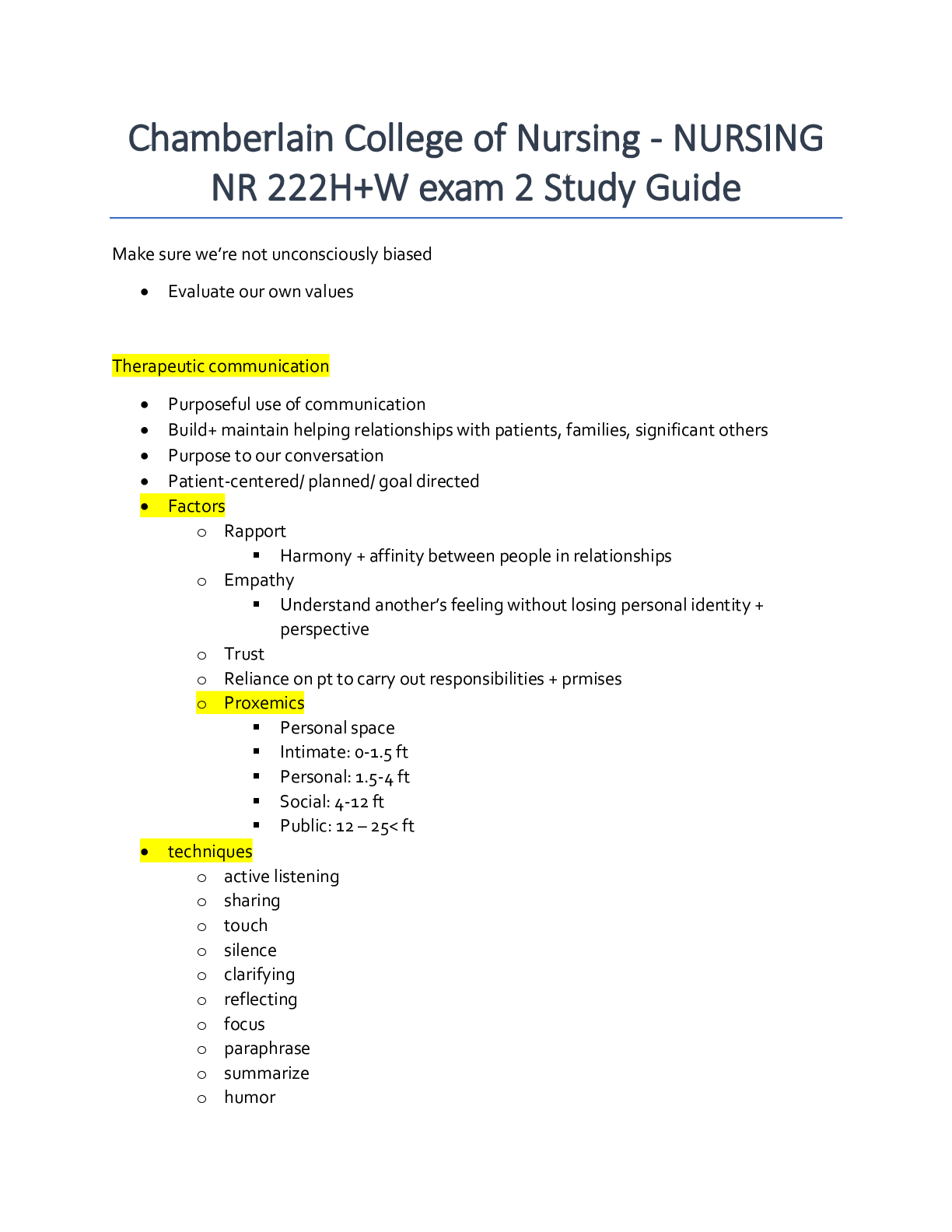Health Care > QUESTIONS & ANSWERS > ATI Care of the Patient with Acute Renal Failure, Chapter 14: Perrin: Understanding the Essentials o (All)
ATI Care of the Patient with Acute Renal Failure, Chapter 14: Perrin: Understanding the Essentials of Critical Care Nursing: Chamberlain College of Nursing NR 341 (A Graded) Latest Questions and Complete Solutions
Document Content and Description Below
1 ATI Care of the Patient with Acute Renal Failure, Chapter 14: Perrin: Understanding the Essentials of Critical Care Nursing: Chamberlain College of Nursing NR 341 (A Graded) Latest Questions and Co... mplete Solutions Perrin: Understanding the Essentials of Critical Care Nursing Chapter 14: Care of the Patient with Acute Renal Failure MULTIPLE CHOICE. Choose the one alternative that best completes the statement or answers the ques 1) Of the following clients in an intensive care unit, who would be at highest risk for the development of acute renal failure with a prerenal cause? A client who is: A) Experiencing acute status asthmaticus. B) Being treated for hypertension following a cerebral vascular accident. C) In skeletal traction following a motor vehicle accident. D) Postoperative from a ruptured abdominal aortic aneurysm. Answer: D Explanation: A) Prerenal failure commonly results from a pronounced reduction in cardiac output due to severe hypotension, hypovolemia, or severe vasoconstriction. Thus, the client who has experienced significant blood loss as in a ruptured aortic aneurysm would be at greatest risk in comparison to the other medical conditions presented. #1 is not correct. Status asthmaticus is a severe airway obstruction that results in respiratory acidosis. There is not an associated reduction in cardiac output associated with this problem. #2 is not correct. Hypertension is associated with the development of chronic renal failure and end stage renal disease. #3 is not correct. Long bone fractures can result in blood loss b is a slower process than with an aneurysm. There is a low risk but the aortic aneurysm has a much higher risk. Nursing Process: Assessment Cognitive Level: Analysis Category of Need: Reduction of Risk Potential–Potential of Complications from Surgical Procedures and Health Alterations B) Prerenal failure commonly results from a pronounced reduction in cardiac output due to severe hypotension, hypovolemia, or severe vasoconstriction. Thus, the client who has experienced significant blood loss as in a ruptured aortic aneurysm would be at greatest risk in comparison to the other medical conditions presented. #1 is not correct. Status asthmaticus is a severe airway obstruction that results in respiratory acidosis. There is not an associated reduction in cardiac output associated with this problem. #2 is not correct. Hypertension is associated with the development of chronic renal failure and end stage renal disease. #3 is not correct. Long bone fractures can result in blood loss b is a slower process than with an aneurysm. There is a low risk but the aortic aneurysm has a much higher risk. Nursing Process: Assessment Cognitive Level: Analysis Category of Need: Reduction of Risk Potential–Potential of Complications from Surgical Procedures and Health Alterations 2 C) Prerenal failure commonly results from a pronounced reduction in cardiac output due to severe hypotension, hypovolemia, or severe vasoconstriction. Thus, the client who has experienced significant blood loss as in a ruptured aortic aneurysm would be at greatest risk in comparison to the other medical conditions presented. #1 is not correct. Status asthmaticus is a severe airway obstruction that results in respiratory acidosis. There is not an associated reduction in cardiac output associated with this problem. #2 is not correct. Hypertension is associated with the development of chronic renal failure and end stage renal disease. #3 is not correct. Long bone fractures can result in blood loss b is a slower process than with an aneurysm. There is a low risk but the aortic aneurysm has a much higher risk. Nursing Process: Assessment Cognitive Level: Analysis Category of Need: Reduction of Risk Potential–Potential of Complications from Surgical Procedures and Health Alterations D) Prerenal failure commonly results from a pronounced reduction in cardiac output due to severe hypotension, hypovolemia, or severe vasoconstriction. Thus, the client who has experienced significant blood loss as in a ruptured aortic aneurysm would be at greatest risk in comparison to the other medical conditions presented. #1 is not correct. Status asthmaticus is a severe airway obstruction that results in respiratory acidosis. There is not an associated reduction in cardiac output associated with this problem. #2 is not correct. Hypertension is associated with the development of chronic renal failure and end stage renal disease. #3 is not correct. Long bone fractures can result in blood loss b is a slower process than with an aneurysm. There is a low risk but the aortic aneurysm has a much higher risk. Nursing Process: Assessment Cognitive Level: Analysis Category of Need: Reduction of Risk Potential–Potential of Complications from Surgical Procedures and Health Alterations 2) The critical care nurse is aware that the drugs that have been implicated in the development of renal failure include: (Select all that apply.) A) Nonsteroidal ant-i nflammatory drugs (NSAIDs) B) Aminoglycosides C) Contrast media D) Antiseizure medications E) ACE inhibitors F) Cyclosporine Answer: A, B, C, E, F Explanation: A) (Note: This requires multiple responses to be correct.) These drugs have been implicated in the development of renal failure. They all can be nephrotoxic so renal function needs to be monitored during therapy. #4 is incorrect. Antiseizure medications are not nephrotoxic. Nursing Process: Diagnosis Cognitive Level: Analysis Category of Need: Reduction of Risk Potential–Potential for Alterations in Body Systems 3 B) (Note: This requires multiple responses to be correct.) These drugs have been implicated in the development of renal failure. They all can be nephrotoxic so renal function needs to be monitored during therapy. #4 is incorrect. Antiseizure medications are not nephrotoxic. Nursing Process: Diagnosis Cognitive Level: Analysis Category of Need: Reduction of Risk Potential–Potential for Alterations in Body Systems C) (Note: This requires multiple responses to be correct.) These drugs have been implicated in the development of renal failure. They all can be nephrotoxic so renal function needs to be monitored during therapy. #4 is incorrect. Antiseizure medications are not nephrotoxic. Nursing Process: Diagnosis Cognitive Level: Analysis Category of Need: Reduction of Risk Potential–Potential for Alterations in Body Systems D) (Note: This requires multiple responses to be correct.) These drugs have been implicated in the development of renal failure. They all can be nephrotoxic so renal function needs to be monitored during therapy. #4 is incorrect. Antiseizure medications are not nephrotoxic. Nursing Process: Diagnosis Cognitive Level: Analysis Category of Need: Reduction of Risk Potential–Potential for Alterations in Body Systems E) (Note: This requires multiple responses to be correct.) These drugs have been implicated in the development of renal failure. They all can be nephrotoxic so renal function needs to be monitored during therapy. #4 is incorrect. Antiseizure medications are not nephrotoxic. Nursing Process: Diagnosis Cognitive Level: Analysis Category of Need: Reduction of Risk Potential–Potential for Alterations in Body Systems F) (Note: This requires multiple responses to be correct.) These drugs have been implicated in the development of renal failure. They all can be nephrotoxic so renal function needs to be monitored during therapy. #4 is incorrect. Antiseizure medications are not nephrotoxic. Nursing Process: Diagnosis Cognitive Level: Analysis Category of Need: Reduction of Risk Potential–Potential for Alterations in Body Systems [Show More]
Last updated: 2 years ago
Preview 1 out of 38 pages
 Latest Questions and Complete Solutions.png)
Buy this document to get the full access instantly
Instant Download Access after purchase
Buy NowInstant download
We Accept:

Reviews( 0 )
$15.50
Can't find what you want? Try our AI powered Search
Document information
Connected school, study & course
About the document
Uploaded On
May 24, 2021
Number of pages
38
Written in
Additional information
This document has been written for:
Uploaded
May 24, 2021
Downloads
0
Views
65


 Questions and Answers (latest Update), All Correct, Download to Score A.png)






, (A Grade), Questions and Answers, All Correct Study Guide, Download to Score A.png)
, Questions and Answers, All Correct Study Guide, Download to Score A.png)
, Latest Questions and Answers with Explanations, All Correct Study Guide, Download to Score A.png)













